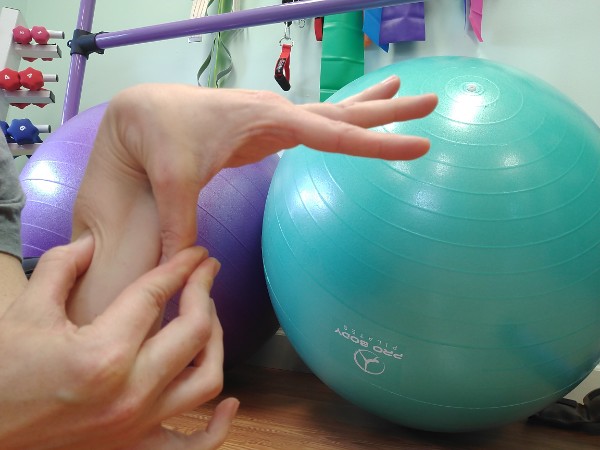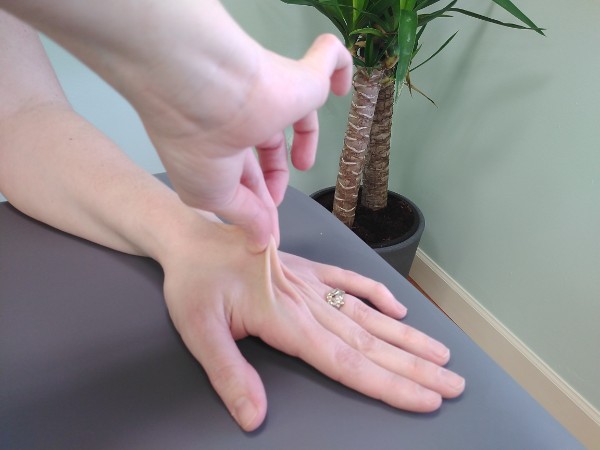 I can bend my thumb down so far that it touches my forearm. This is one of the stranger and more visible signs of hypermobility spectrum disorder (HSD) and Hypermobility Ehlers-Danlos Syndrome (EDS-HT). Other signs are hyperextension at the elbows and knees, being able to place your hands flat on the floor when bending forward at the waist while keeping your knees straight, and being able to bend your little finger back past 90 degrees. These are the signs used to diagnose hypermobility, which is simply a laxity or looseness in a person’s ligaments and connective tissue.
I can bend my thumb down so far that it touches my forearm. This is one of the stranger and more visible signs of hypermobility spectrum disorder (HSD) and Hypermobility Ehlers-Danlos Syndrome (EDS-HT). Other signs are hyperextension at the elbows and knees, being able to place your hands flat on the floor when bending forward at the waist while keeping your knees straight, and being able to bend your little finger back past 90 degrees. These are the signs used to diagnose hypermobility, which is simply a laxity or looseness in a person’s ligaments and connective tissue.
To people who are used to having stiffness in their joints, hypermobility can seem like a superpower. How many people wish they were more flexible? But if your connective tissue is so lax that your ligaments aren’t doing a great job of stabilizing your joints, then you could be at increased risk of joint dislocations and subluxations. In this case, the muscles have to step it up and do the stabilizing work. That means that people who are hypermobile need to be stronger than they would need to be if they had typical connective tissue.
 Hypermobility exists on a spectrum. The diagnostic criteria are based on signs and symptoms and there is no consensus among medical professionals as to how to distinguish EDS-HT from HSD although EDS-HT is generally recognized as the more severe end of the spectrum. For some people, this laxity of connective tissue affects not only their joints but all of the connective tissues in the body to varying degrees. Many patients who have hypermobility also have very stretchy skin, often thinking that everyone’s skin is like that (because who goes around grabbing other people’s skin and trying to stretch it?). Other signs and symptoms can include abnormal scar tissue formation, varicose veins, digestive issues, immunity to or delayed response to anesthetics, vision problems, pelvic floor dysfunction, and more.
Hypermobility exists on a spectrum. The diagnostic criteria are based on signs and symptoms and there is no consensus among medical professionals as to how to distinguish EDS-HT from HSD although EDS-HT is generally recognized as the more severe end of the spectrum. For some people, this laxity of connective tissue affects not only their joints but all of the connective tissues in the body to varying degrees. Many patients who have hypermobility also have very stretchy skin, often thinking that everyone’s skin is like that (because who goes around grabbing other people’s skin and trying to stretch it?). Other signs and symptoms can include abnormal scar tissue formation, varicose veins, digestive issues, immunity to or delayed response to anesthetics, vision problems, pelvic floor dysfunction, and more.
It is important for people who have characteristics of hypermobility to build a team of providers who have an understanding of the multi-system, multifactorial effects of EDS-HT and HSD. As a person who experiences hypermobility in my own body, has worked with many hypermobile patients/clients, and has studied hypermobility extensively, I may be able to help you address the musculoskeletal aspects of hypermobility. To learn more, please call our office at (513) 445-WELL (9355) or schedule an appointment through our Client Portal.
For more information on EDS-HT, HSD, as well as other EDS subtypes I highly recommend checking out The Ehlers-Danlos Society.
This is the first in a series of articles on hypermobility; check back for articles regarding hypermobility and proprioception, feeling “tight,” pain and therapy, and more.